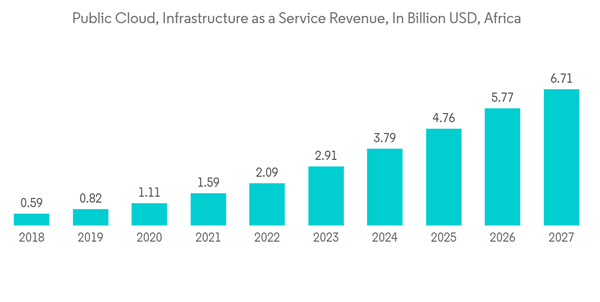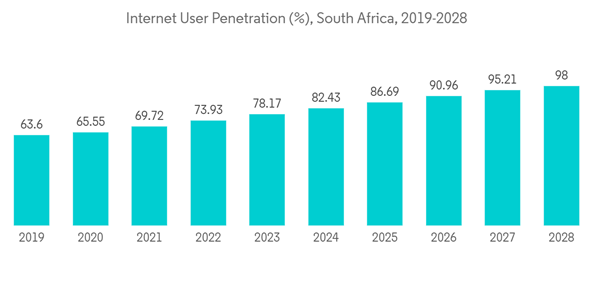Key Highlights
- The upcoming IT load capacity of the Africa data center construction market is expected to reach 1226 MW by 2029.
- The region's construction of raised floor area is expected to increase 5.2 million sq. ft by 2029.
- The region's total number of racks to be installed is expected to reach 260K units by 2029. South Africa is expected to house the maximum number of racks by 2029.
- There are close to 70 submarine cable systems connecting Africa, and many are under construction. One such submarine cable that is estimated to start service in 2024 is Africa-1, which stretches over 10,000 Kilometers with a landing point in Port Said, Ras Ghareb, Egypt.
Africa Data Center Server Market Trends
IT & Telecommunication Segment Holds the Major Share.
- The need for data localization has recently encouraged global cloud aggregators to introduce cloud data centers in the country. This highlights regional investment's growing demand and favorability, helping sectors like the cloud grow.
- Cloud infrastructure offers users increased scalability and remote access, helping companies choose it as a critical part of their operations in technology-driven businesses. The market share for cloud users is expected to increase from 7.25% in 2022 to around 8.6% by 2029. Since data centers and payrolls of highly skilled cloud maintenance staff are cheaper than big international cloud aggregators, even public services rely on service providers like Google, Microsoft, and AWS.
- As data colonialism is rampant, African governments and private companies would seek more data centers and cloud service providers on domestic premises to keep data within the continent and secure within their territory for added security. As the authorities see the need to improve the contribution of their regions to the international markets, the improved cloud scenario would generate significant demand for data centers in the region.
- Further, the World Bank data highlighted how Africa would require significant investments for better internet connectivity, with new 4G base stations and other infrastructure for long-term network evolution. As the network evolves in the region, it would directly impact the need for more data centers to cater to the increase in data traffic, which is expected to reach about 7 gigabytes per month per subscriber by 2025 through nearly 30 million 5G subscribers.
- The increased bandwidth speeds increased the consumption of data on mobile phones from 0.6 GB in 2016 to 2.25 GB in 2022. These are expected to reach around 11.3 GB by 2029. In East Africa, Ethiopia witnessed the Development Finance Corporation (DFC) backing a consortium of telecom companies to acquire a mobile license in the country, availing about USD 500 million for the same, followed by backing Liquid Telecom's data center expansion in the continent through a USD 300 million grant. Implementing hybrid cloud services would help the telecom segment deploy cloud services, offer lower downtime, and create demand for data centers in the region. Thus, the demand for data center servers is expected to increase in the coming years as a result of these instances in the region.
South Africa is Expected to Witness Significant Growth in the Region
- South Africa is the most prominent country for data centers in Africa. Data consumption in the South African market is increasing gradually from various end-user industries. For instance, South Africa had 41.19 million internet users by the start of January 2022, and the internet penetration rate stood at 68.2%.
- The growing adoption of e-commerce, especially in electronics and retailers, followed by fashion, sport, and health and beauty products, is among the key drivers for the growth of colocation services in the country. The COVID-19 pandemic had a positive impact on the market.
- The establishment of Special Economic Zones (SEZs), Free Trade Zones (FTZs), and smart city investments have boosted the South African data center construction industry. There is a surge in cloud use, data localization, and the deployment of new technologies such as 5G and IoT. The increased adoption of advanced IT infrastructure and migration from on-premise to colocation and managed services is expected to attract investors to develop data center facilities in the country over the coming years.
- A large urban population of 68.3% in South Africa at the start of 2022 increased the adoption of online banking platforms. The e-commerce industry recorded an increase of 11%, with its revenue reaching USD 7.2 billion in 2021. The South African e-commerce industry helped drive the global industry's growth rate of 18%. Owing to the above instances, the demand for data centers is increasing, resulting in the growth of data center servers in South Africa.
- Financial inclusion in South Africa is primarily fueled by mobile and digital banking. However, cash withdrawals, which are frequently performed at supermarket checkout points, continue to dominate banking activity despite the widespread adoption of digital banking. Mastercard's New Payment Index 2022 stated that various digital payment methods are growing in South Africa. Consumers in South Africa are increasingly and actively using solutions like Bitcoin, digital cards, biometric payments, Buy Now Pay Later (BNPL), and open banking for various financial transactions in their daily lives. The same source also stated that 95% of South Africans used one or more developing digital payment methods in 2021. Such factors may boost the demand for data center services from the segment during the forecast period.
Africa Data Center Server Industry Overview
The upcoming DC construction projects in the region will increase the demand for data center servers in the coming years. The Africa data center server market is moderately consolidated with a few major players, such as Dell Inc., Hewlett Packard Enterprise, Fujitsu, and Lenovo Group Limited. These major players, with a prominent market share, focus on expanding their regional customer base.In August 2023, Dell Inc. is transitioning its servers with Next-generation Dell PowerEdge Servers from OSA to ESA with PowerEdge R760 powered by 4th generation Intel Xeon Processors.
In January 2023, Cisco Systems Inc. announced the launch of the 7th generation of UCS C-Series and X-Series servers, powered by 4th generation Intel Xeon Scalable processors. With support for the latest Intel processors, Cisco has launched two new blades for the X-Series: the Cisco UCS X210c M7 Compute Node and the Cisco UCS X410c M7 Compute Node.
Additional Benefits:
- The market estimate (ME) sheet in Excel format
- 3 months of analyst support
This product will be delivered within 2 business days.
Table of Contents
Methodology

LOADING...










